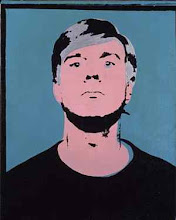coming in in all directions
white shining silver studs with their nose in flames,
He saw horses, horses, horses, horses, horses, horses, horses, horses

Fine Form: The Horse in Art, Installation shot, Summerfield Gallery: foreground, Andrew Logan, Life, Birth and Death,2006-8; back, left, Elisabeth Frink, Horse and Rider (Robed), 1985; back, right, Mark Wallinger, Half-Brother (Exit to Nowhere - Machiavellian), 1994-5
Fine Form: The Horse in Art is an exhibition marking the centenary of the Cheltenham Festival (15th - 18th March): it will be in the Summerfield Gallery, Pittville Studios and the Centaur at Cheltenham Racecourse until 30th April. The exhibition draws on the collections of the Tate, the Arts Council and Cheltenham Art Gallery & Museum.
The glittery-winged forms of Andrew Logan's Pegasuses, Life, Birth and Death, dominate the installation in Summerfield Gallery (see above) but are in fine company, notably works by Mark Wallinger, Tania Kovats, Elisabeth Frink, William Tucker and Christopher Le Brun, amongst others.
Wallinger's Half-Brother (Exit to Nowhere - Machiavellian), 1994-5, is a life-size portrait of a horse comprised of separate forequarter and hindquarter, in explicit acknowledgement of the place of pedigree in the thoroughbred.

Mark Wallinger, Half-Brother (Exit to Nowhere - Machiavellian), 1994-5 (Tate Collection)
From the sublime to the ridiculous, Wallinger also shows A Real Work of Art, 1994, a tiny, diecast model of horse and rider, the jockey painted in the suffragette colours of green, violet and white in a reference to Emily Davison who threw herself under the King's horse at Epsom Derby in 1913.Mark Wallinger, A Real Work of Art, 1994 (Arts Council Collection)
The work also refers to one of Wallinger's more ambitious and conceptual works wherein he bought (through a syndicate) a real racehorse which he named A Real Work of Art.
Tania Kovats became fascinated by the Uffington White Horse while undertaking a residency in Oxford in 2006: her collection, Museum of the White Horse is the result and comprises both a collection of objects (books, stamps, models, etc) and a sequence of pencil drawing of objects from the collection. (See also, appendix, below.)
Tania Kovats, Museum of the White Horse: from top, Small Finds (detail), White Horses by Jacky, 45 rpm single, 2007, Books from the Museum of the White Horse Library, Non-Fiction, 2007 (all, Arts Council Collection).
Finally, one of the most striking images in the show is a photograph by Tim Flach: Windows - Chestnut, 2008.

Appendix
As it is not possible to read all the titles in the reproduction of Tania Kovats' drawing, Books from the Museum of the White Horse Library, Non-Fiction, 2007 (see above), and because I am an ex-librarian (see also, below) and a bibliographile(?), I have taken the liberty of compiling a bibliography for the drawing:
Tania Kovats: from the Museum of the White Horse Library, Non-Fiction, 2007, a bibliography.
NB, while the authors and titles are accurate, the places and dates of publication may not necessarily match the actual editions drawn. Books are listed in the order that they appear in the drawing, left to right.
Miles, David et al (2004) Uffington White Horse and Its Landscape: Investigations at White Horse Hill Uffington, 1989-95 and Tower Hill Ashbury, 1993-4, (Thames Valley Landscape Monographs), Oxford: Oxford University School of Archaeology
Williams, Dorian (1975) Great Riding Schools of the World, London, Weidenfeld & Nicolson
Cahill, Marie (1991) The Owner’s Comprehensive Guide to Training & Showing Your Horse, London: Bison Publishing
Tippett, Frank (1975) The First Horsemen (the Emergence of Man), New York: Time-Life Books
Lock, Gary et al (2005) Segsbury Camp: Excavations in 1996 and 1997 at an Iron Age Hillfort on the Oxfordshire Ridgeway (Oxford University School of Archaeology Monograph), Oxford: Oxford University School of Archaeology
Gianoli, Luigi (1969) Horses and Horsemanship through the Ages, New York: Crown
Ingrams, Richard (1988) The Ridgeway: Europe’s Oldest Road, London: Phaidon
Coatsworth, Elisabeth (1973) The White Horse of Morocco, London: Blackie
Lady Wentworth (1958) The World’s Best Horse, London: Allen & Unwin
Dames, Michael (1978) The Silbury Treasure: The Great Goddess Rediscovered, London: Thames & Hudson
Jankovich, Miklos and Dent, Anthony (1971) They Rode into Europe, London: Harrap
Communicationes Archaeologicae Hungariae, (1982), Budapest
Appleton, J. H. (1975) The Experience of Landscape, London: Wiley-Blackwell
Vansittart, Peter (1985) Paths from a White Horse: A Writer’s Memoir, London: Quartet
Summerhays, R. S. (1975) Summerhays' Encyclopaedia for Horsemen, London: Frederick Warne
Laming, Annette (1959) Lascaux, London: Penguin
Hanbury-Tenison, Robin (1985) White Horses over France: From the Carmargue to Cornwall, London: Grafton
Burridge, Richard (2004) The Grey Horse: The True Story of Desert Orchid, London: Aurum Press
Summerhays, R. S. (1963) The Observer’s Book of Horses and Ponies, London: F. Warne
[unidentified]
Hawkes, Jacquetta (1951) A Land, Cresset Press
Billington, Sandra and Green, Miranda eds. (1996) The Concept of the Goddess, London: Routledge
Coles, Alex ed. (2001) Archaeology: Mark Dion, London: Black Dog Publishing
Buchli, Victor and Lucas, Gavin (2001) Archaeologies of the Contemporary Past, London: Routledge
Arthus-Bertrand, Yann and Gourand, Jean-Louis (2007) Horses, London: Thames & Hudson
Deeping, George Warwick (1934) The Man on the White Horse, London: Cassell






No comments:
Post a Comment